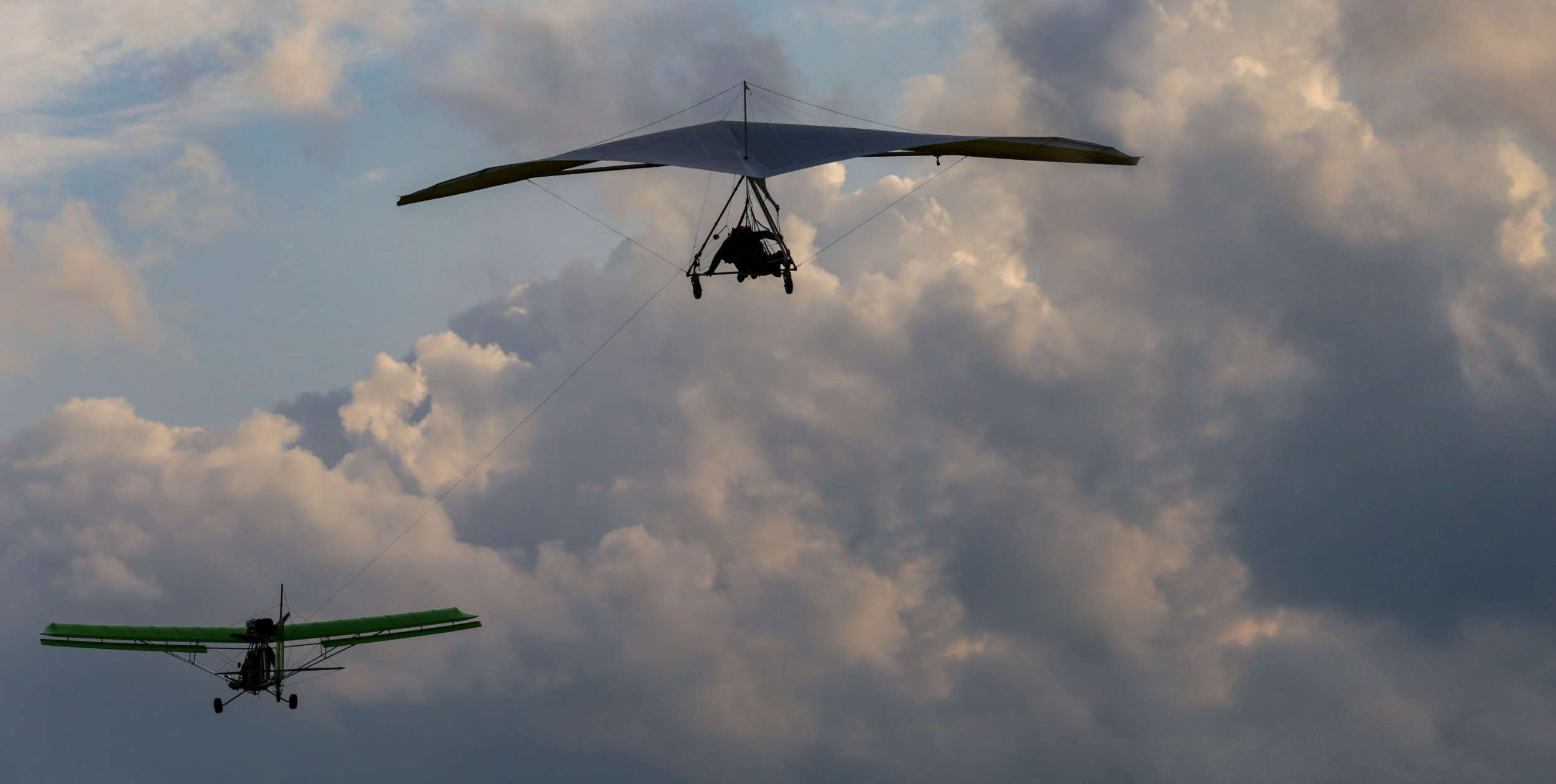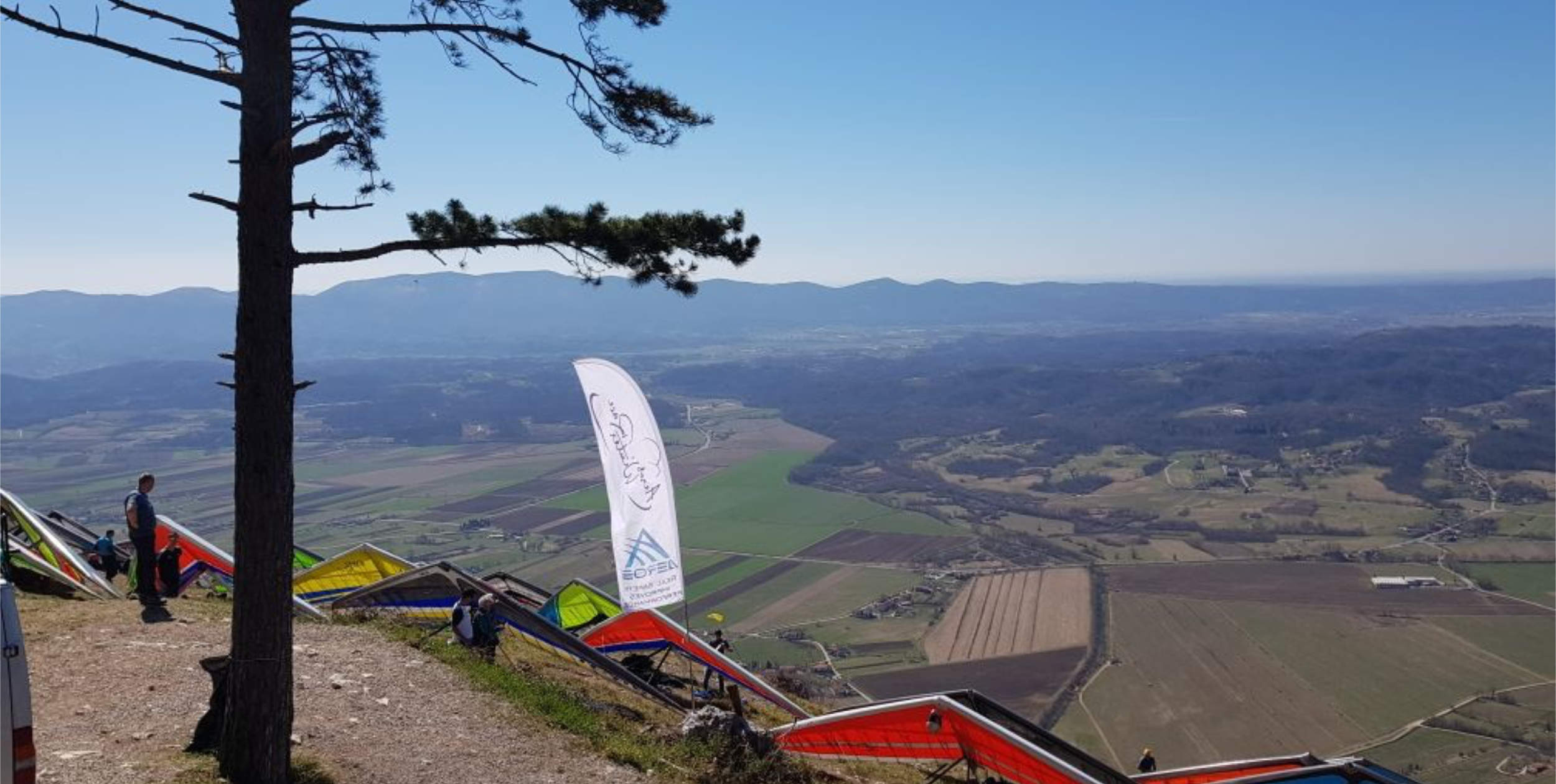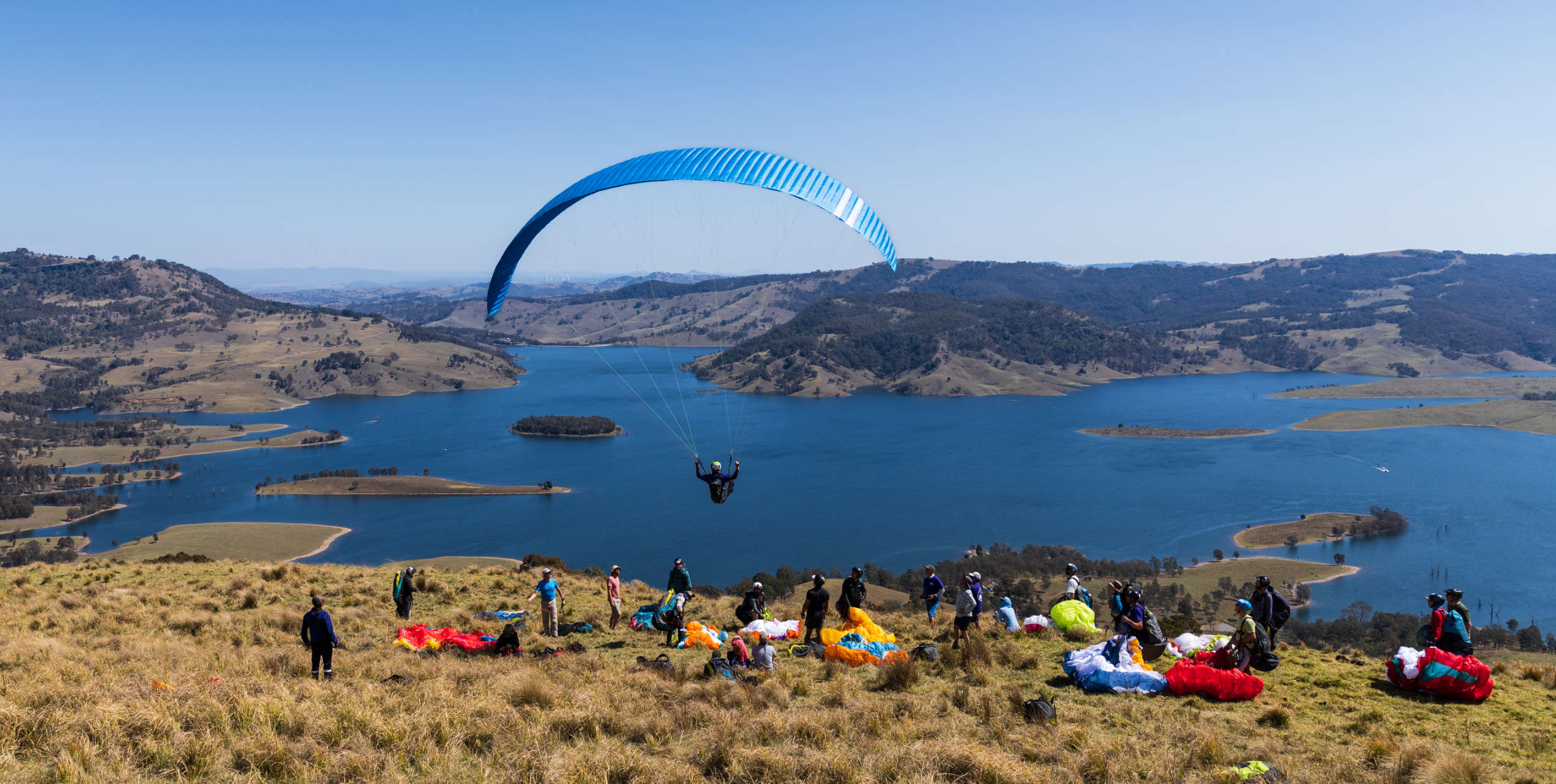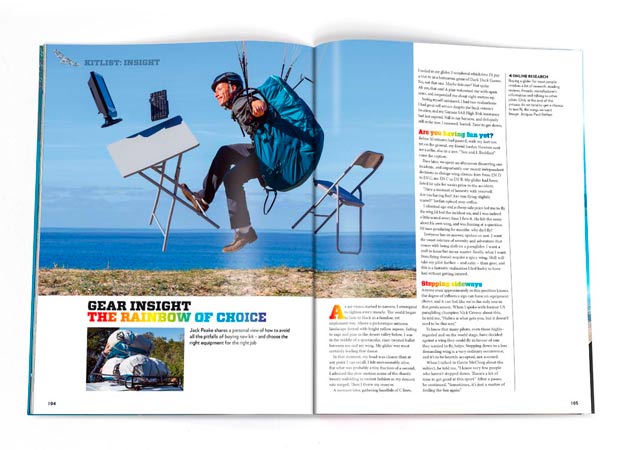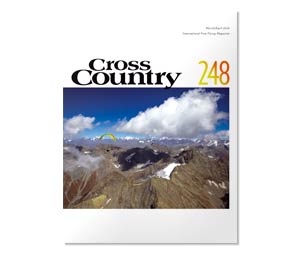 Tumbled mid flight, Adam Parer found himself separated from his glider and in free fall cocooned in his hang gliding harness
Tumbled mid flight, Adam Parer found himself separated from his glider and in free fall cocooned in his hang gliding harness
Midway through a 209 km race to Manilla Airstrip, flying at around 50 km/h, I hit a thermal and started to climb. I climbed for about a ¼ of the first turn, then the ‘G’ began to lighten and the nose started to ease over. For that first split second I expected a ‘wire slapper’ to precede a return into normal flight. This didn’t happen. The ‘G’ went to zero and the nose continued over. I braced onto the basebar and attempted to pull in and maintain hang position, but couldn’t. The ‘G’ went negative and the nose went over. I maintained some grip on the basebar and kept my torso as close to it as possible but the leg/boot end of the harness continued to move toward the undersurface and my upper body eventually followed. The nose-over motion accelerated and I lost contact with the basebar. As I fell weightless through the air the glider proceeded to tumble and I cleared the wing without making contact as it passed underneath, inverted. The glider came back around upright and I bottomed out with a thud when the hang strap went tight; for a split second I thought the glider might stabilise. However, it still had more than enough momentum to enter a second tumble. Again, I don’t recall hitting any part of the glider as it went over a second time. Once again I fell with another thud when the hang straps went tight, but this time the tension lasted for a much shorter period of time. I went weightless, as if falling straight down for several metres, before feeling the beginning of a rotation/spin in the horizontal plane like a sycamore seed. I suspect the sidewire had broken and the wings had begun to fold together. The first spin finished quickly, but I entered the second with much more speed. I tried to go for the parachute handle but the ‘G’ force had already built up significantly. Soon my arms, then my head, were forced and held out away from the centre of rotation preventing me from reaching the parachute handle. I realised I was in a bad way but my life depended on getting to the parachute. Hard as I tried with all my strength, my arms remained straight pointing away from the harness.
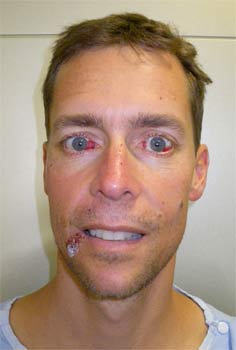
Adam Parer five days after the hang glider accident. The haemotoma in his eyes is beginning to heal.
What followed is something I could never have imagined: a force developed through the rotations, an incredible acceleration in speed, rapidly increasing the ‘G’ force. I’ve watched video of similar motion when a glider folds its wings, but on those occasions the rotation seems to reach a maximum after a number of rotations. Not in this case. The ‘G’ force continued to increase and was transverse to my prone position, pooling blood ventrally in the front half of my body causing my eyes to sustain advanced haematoma. By the fifth and sixth rotation the load was so severe that I knew the equipment would fail soon. Hopefully before I sustained serious injury. Then in a split second the ‘G’ force went to zero and I was being thrown through space. At least I could move my arms and hold my head up. I reached for the parachute handle. I was aware of moving horizontally with a lot of velocity and could also hear the airspeed accelerating very quickly. My trajectory through the air was like a thrown projectile, but it soon turned into freefall. That’s when I realised then I’d definitely separated from the glider. I located the parachute handle and pulled with my right hand but it didn’t budge. After a few more heaves I realised the parachute was going to need a lot more persuasion to come out. We’d later discover that the back plate had failed catastrophically deforming the opening of the parachute port.
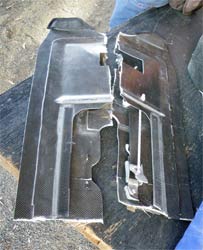
Catastrophic failure of Adam Parer's backplate which broke into three pieces
As I fought to remove the parachute I was aware of free falling straight downward in a boot-first/head-up/’pencil’ position – something later confirmed by eye witnesses. Over the next five seconds, while I continued to struggle with the parachute, the sound of the airflow achieved its maximum and I realised I was at terminal velocity. One arm was not enough, so I reached down with the left and with both hands heaved on the handle. After another couple of seconds I felt the parachute finally come loose. I threw it sideways, let go and waited. What came next was the most painful and violent impact I have ever felt in my life, like I had been torn in half. Extreme pain instantly filled my body with the worst of it concentrated in my chest and upper back. I knew I’d sustained serious injury and immediately suspected my back was broken. I looked up just enough to see one of the most beautiful things I’d ever seen: the clean circular shape of the front third of my red parachute, taut, inflated and intact. The airflow was quiet now and the earth was no longer hurtling towards me. In less than 15 seconds I had fallen 4,000’ [1,220 m]. The parachute and harness survived the deployment and so had I, but not without injury. And the pain suggested I was in a real bad way. The thought of paralysis filled my mind and I needed to know. I tried to wriggle my fingers and they moved. I thought with some dread, ‘My legs?’ I wriggled my feet and they moved too. Relief mixed with the pain, but concern remained that my back was probably broken despite the spinal cord being intact. I needed a soft landing to protect what wasn’t damaged. I looked down and the remaining 2000’ came up very slowly. I could only just breathe. I needed to get down as soon as possible and get help. After a minute of trying to get more air into my lungs my colour vision started to fade: I was greying out. As I gradually blacked out I feared I’d now sustain fatal internal injuries. My thoughts immediately went to my wife who passed away earlier this year. I hoped that if this was what was happening to me then at least I’d be with her soon. I felt content for the first time in four months. My soul mate, taken away so early in our life, with whom I’d shared so much. Pain was no longer on my mind and I felt calm. A few moments passed before awareness came over me. I wasn’t dying. I would survive. This was not my time. The peace gave way to the pain, which returned with a vengeance. Shock set-in and I passed out. When I came too I was on my back looking up at the sky. I looked around and suddenly the realisation of what had just happened came back all at once. I said out loud in astonishment and relief, “I survived!” Then I started to get dragged backwards at a walking pace for a few feet before coming to a stop. I looked over my shoulder and there was that beautiful red coloured parachute again, right behind me on the ground and still inflated. A gust came through and again I slowly got dragged along the ground a few more feet. The pain was worse than ever now and I had to get out of the harness. I rechecked arm and leg movement and all were still working. I unclipped the leg loops and the waist belt. As I struggled in vain to undo the chest buckle I heard a voice from behind: a farmer who had seen my parachute from a distance sitting inflated on the ground had driven over to check it out. “Can I give you a hand son?” he asked as he walked into my field of view where I lay on my back. “Yes, undo this buckle and call an ambulance”, was my reply. He too struggled with the chest strap and I thought it might be jammed from the deployment. I had one more go and it released. I rolled out of the harness, stood up, walked over to the shade of a nearby tree and carefully crouched in the least painful position. There I stayed for the next hour and a half until I could be evacuated. Three things I saw that day will stay with me for the rest of my life. First, a glimpse of that High Energy parachute sitting high above and taking me safely to earth after the wildest and most painful ride of my life. And again as I lay unconscious in that field then waking up, looking over my shoulder to see it there once again, that big red parachute on the ground and still inflated as if it continued to watch over me. Second was the sight of Oli, Dave, Phil and Chris all coming into land only metres away from where I crouched in absolute searing pain. I watched them get out of their harnesses one by one and I felt much better straight away. They rallied around me in relative silence but their concern was obvious. It took 45 minutes for the ambulance to arrive but the pilots urged the paramedics on and tried to hurry them to do what ever was necessary to get me out of there and into hospital. I heard Oli pleading with the Ambulance Officer, “You need to get the helicopter, just send the helicopter right now”. “Dave sat next to me and relayed my answers as I could hardly speak. I can’t describe how good it was to have them there. Then the red and yellow Westpac helicopter arrived! The crew was on the ball and once airborne I finally realised I was safe. We lifted off and headed straight for The John Hunter Hospital in Newcastle. As I was wheeled in through the hospital doors a familiar face in a green medical gown stood there waiting, Conrad Loten, fellow hang glider pilot and head of the Emergency Department took over my treatment and directed his staff calmly but with obvious authority and competence. After the CAT scan Conrad came over to my bed and confirmed the damage: six broken ribs, a collapsed lung, broken sternum and a flail fracture of the chest. “What about my back?” I asked. With the slight smile he assured me the back was in perfect condition, no damage to the spine whatsoever. I was very lucky to have survived this accident and many things were in my favour including a lot of luck. The specialists believe health and fitness gave me a big advantage not only aiding in the healing but also preventing more serious injury. Since my wife passed away some months ago I’ve lost a bit of weight and I suspect the less momentum I had when the parachute inflated the better. She always looked out for me in the most unusual and often in the least obvious of ways and it feels she continues to. In hindsight I began preparation for this accident 18 months ago. At Forbes in 2007 I watched Austrian pilot Andreas Orgler experience an almost identical accident. While his incident didn’t involve the violent sycamore rotation, he did tumble twice and then separated from his glider. His pilotless wing then descended straight at me, head-on, and only just cleared mine with a closing speed that would have certainly brought me down too. Meanwhile Andreas quickly deployed his parachute during his freefall and well before achieving terminal velocity. Despite his much lower speed the inflation was explosive and the parachute failed. He continued to freefall right before my eyes. Witnessing such a traumatic event left me deeply affected for a long time but it was the motivation to understand why it happened and then re-equip with the most advanced Skyline harness and a new High Energy parachute. This equipment could and did survive this rare and ‘unlikely’ event where pilot and glider are separated in flight. Andreas’ accident in Forbes helped prepare me to survive mine at Gulgong. This may be a small consolation to those who have never met me and knew Andreas, but the fact is there are many people here now who are very relieved and very happy because I am alive. He helped save my life. I am very happy to be alive. My understanding of flying hasn’t changed in any way and I am not left with any doubt about the safety and risks of hang gliding. I hope to fly again but that depends on my ribs. If I get to fly for another 15 years I’d be surprised if I ever come across the same air that lead to my accident. Nothing I could have done and no sort of equipment would have behaved differently. The Rev is the most stable and beautiful glider I have flown in and when I eventually re-equip it will be with the same gear. The air was tipping me over no matter what. Check your equipment and update to the best, the extra few $100 is worth it! Images of Adam’s equipment showing some of the damage sustained during the incident.

Back-up webbing separated when stitching failed due to diagonal load after the 6th rotation in the spin.

Backbone of the glider, the keel, looking worse for wear. Downtube not much better. The stinger extension was never found. Keel wire failure at crimp.

Nose wire failed at crimp.
More images can be seen on Adam’s blog pages. Read more ‘There I was…’ stories: The Croatian Survivor • Got news? Send it to us at news@xccontent.local. Fair use applies to this article: if you reproduce it online, please credit correctly and link to xcmag.com or the original article. No reproduction in print. Copyright remains with Adam Parer. Thanks! Subscribe to the world’s favourite hang gliding and paragliding magazine Home

